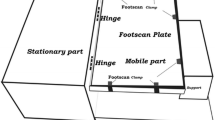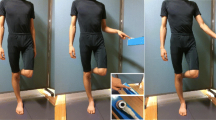Abstract
Purpose
This study was aimed at determining the relationship between ankle plantar flexor force steadiness and postural control during single leg standing on stable and unstable platforms.
Methods
For the thirty-three healthy participants, force steadiness, at target torques of 5%, 20%, and 50% of the maximum voluntary torque (MVT) of the ankle plantar flexors, was measured. Force steadiness was calculated as the coefficient of variation of force. Single leg standing on stable and unstable platforms was performed using the BIODEX Balance System SD. The standard deviation of the anteroposterior center of pressure (COP) displacements was measured as the index for postural control. During both measurements, muscle activities of the soleus were collected using surface electromyography.
Results
On the stable platform, the COP fluctuation significantly correlated with force steadiness at 5% of MVT (r = 0.512, p = 0.002). On the unstable platform, the COP fluctuation significantly correlated with force steadiness at 20% of MVT (r = 0.458, p = 0.007). However, the extent of muscle activity observed for a single leg standing on both stable and unstable platforms was significantly greater than the muscle activity observed while performing force steadiness tasks at 5% and 20% of MVT, respectively.
Conclusion
Postural stability during single leg standing on stable and unstable platforms may be related to one’s ability to maintain constant torque at 5% and 20% of MVT regardless of the muscle activity. These results suggest that the required abilities to control muscle force differ depending on the postural control tasks.


Similar content being viewed by others
Abbreviations
- COP:
-
Center of pressure
- CV:
-
Coefficient of variation
- EMG:
-
Electromyography
- MVC:
-
Maximum voluntary contraction
- MVT:
-
Maximum voluntary torque
- RMS:
-
Root mean square
References
Brown SR, Brughelli M, Lenetsky S (2018) Profiling single-leg balance by leg preference and position in rugby union athletes. Mot Control 22(2):183–198. https://doi.org/10.1123/mc.2016-0062
Carlyle JK, Mochizuki G (2018) Influence of post-stroke spasticity on EMG-force coupling and force steadiness in biceps brachii. J Electromyogr Kinesiol 38:49–55. https://doi.org/10.1016/j.jelekin.2017.11.005
Carville SF, Perry MC, Rutherford OM, Smith IC, Newham DJ (2007) Steadiness of quadriceps contractions in young and older adults with and without a history of falling. Eur J Appl Physiol 100(5):527–533. https://doi.org/10.1007/s00421-006-0245-2
Castronovo AM, Mrachacz-Kersting N, Stevenson AJT, Holobar A, Enoka RM, Farina D (2018) Decrease in force steadiness with aging is associated with increased power of the common but not independent input to motor neurons. J Neurophysiol 120(4):1616–1624. https://doi.org/10.1152/jn.00093.2018
Cimadoro G, Paizis C, Alberti G, Babault N (2013) Effects of different unstable supports on EMG activity and balance. Neurosci Lett 548:228–232. https://doi.org/10.1016/j.neulet.2013.05.025
Day J, Bent LR, Birznieks I, Macefield VG, Cresswell AG (2017) Muscle spindles in human tibialis anterior encode muscle fascicle length changes. J Neurophysiol 117(4):1489–1498. https://doi.org/10.1152/jn.00374.2016
Ema R, Saito M, Ohki S, Takayama H, Yamada Y, Akagi R (2016) Association between rapid force production by the plantar flexors and balance performance in elderly men and women. Age (Dordr) 38(5–6):475–483. https://doi.org/10.1007/s11357-016-9949-3
Enoka RM, Christou EA, Hunter SK, Kornatz KW, Semmler JG, Taylor AM, Tracy BL (2003) Mechanisms that contribute to differences in motor performance between young and old adults. J Electromyogr Kinesiol 13(1):1–12. https://doi.org/10.1016/s1050-6411(02)00084-6
Feeney DF, Mani D, Enoka RM (2018) Variability in common synaptic input to motor neurons modulates both force steadiness and pegboard time in young and older adults. J Physiol 596(16):3793–3806. https://doi.org/10.1113/JP275658
Fitzpatrick R, Rogers DK, McCloskey DI (1994) Stable human standing with lower-limb muscle afferents providing the only sensory input. J Physiol 480(Pt 2):395–403. https://doi.org/10.1113/jphysiol.1994.sp020369
Garcia-Masso X, Pellicer-Chenoll M, Gonzalez LM, Toca-Herrera JL (2016) The difficulty of the postural control task affects multi-muscle control during quiet standing. Exp Brain Res 234(7):1977–1986. https://doi.org/10.1007/s00221-016-4602-z
Harwood B, Cornett KM, Edwards DL, Brown RE, Jakobi JM (2014) The effect of tendon vibration on motor unit activity, intermuscular coherence and force steadiness in the elbow flexors of males and females. Acta Physiol (Oxf) 211(4):597–608. https://doi.org/10.1111/apha.12319
Horak FB (2006) Postural orientation and equilibrium: what do we need to know about neural control of balance to prevent falls? Age Ageing 35(Suppl 2):ii7–ii11. https://doi.org/10.1093/ageing/afl077
Hunter SK, Pereira HM, Keenan KG (2016) The aging neuromuscular system and motor performance. J Appl Physiol 121(4):982–995. https://doi.org/10.1152/japplphysiol.00475.2016
Jacobs JV, Horak FB (2007) Cortical control of postural responses. J Neural Transm (Vienna) 114(10):1339–1348. https://doi.org/10.1007/s00702-007-0657-0
Kallio J, Sogaard K, Avela J, Komi P, Selanne H, Linnamo V (2012) Age-related decreases in motor unit discharge rate and force control during isometric plantar flexion. J Electromyogr Kinesiol 22(6):983–989. https://doi.org/10.1016/j.jelekin.2012.05.009
Kornatz KW, Christou EA, Enoka RM (2005) Practice reduces motor unit discharge variability in a hand muscle and improves manual dexterity in old adults. J Appl Physiol 98(6):2072–2080. https://doi.org/10.1152/japplphysiol.01149.2004
Kouzaki M, Shinohara M (2010) Steadiness in plantar flexor muscles and its relation to postural sway in young and elderly adults. Muscle Nerve 42(1):78–87. https://doi.org/10.1002/mus.21599
Mani D, Feeney DF, Enoka RM (2019) The modulation of force steadiness by electrical nerve stimulation applied to the wrist extensors differs for young and older adults. Eur J Appl Physiol 119(1):301–310. https://doi.org/10.1007/s00421-018-4025-6
Masani K, Popovic MR, Nakazawa K, Kouzaki M, Nozaki D (2003) Importance of body sway velocity information in controlling ankle extensor activities during quiet stance. J Neurophysiol 90(6):3774–3782. https://doi.org/10.1152/jn.00730.2002
Moritz CT, Barry BK, Pascoe MA, Enoka RM (2005) Discharge rate variability influences the variation in force fluctuations across the working range of a hand muscle. J Neurophysiol 93(5):2449–2459. https://doi.org/10.1152/jn.01122.2004
Nandi T, Fisher BE, Hortobagyi T, Salem GJ (2018) Increasing mediolateral standing sway is associated with increasing corticospinal excitability, and decreasing M1 inhibition and facilitation. Gait Posture 60:135–140. https://doi.org/10.1016/j.gaitpost.2017.11.021
Negro F, Holobar A, Farina D (2009) Fluctuations in isometric muscle force can be described by one linear projection of low-frequency components of motor unit discharge rates. J Physiol 587(Pt 24):5925–5938. https://doi.org/10.1113/jphysiol.2009.178509
Oomen NM, van Dieen JH (2017) Effects of age on force steadiness: a literature review and meta-analysis. Ageing Res Rev 35:312–321. https://doi.org/10.1016/j.arr.2016.11.004
Oshita K, Yano S (2010) Relationship between force fluctuation in the plantar flexor and sustainable time for single-leg standing. J Physiol Anthropol 29(3):89–93. https://doi.org/10.2114/jpa2.29.89
Oshita K, Yano S (2011) Low-frequency force steadiness practice in plantar flexor muscle reduces postural sway during quiet standing. J Physiol Anthropol 30(6):233–239. https://doi.org/10.2114/jpa2.30.233
Oshita K, Yano S (2012) Association of force steadiness of plantar flexor muscles and postural sway during quiet standing by young adults. Percept Mot Skills 115(1):143–152. https://doi.org/10.2466/15.26.29.PMS.115.4.143-152
Peterka RJ (2002) Sensorimotor integration in human postural control. J Neurophysiol 88(3):1097–1118. https://doi.org/10.1152/jn.2002.88.3.1097
Smith JW, Marcus RL, Peters CL, Pelt CE, Tracy BL, LaStayo PC (2014) Muscle force steadiness in older adults before and after total knee arthroplasty. J Arthroplasty 29(6):1143–1148. https://doi.org/10.1016/j.arth.2013.11.023
Solis-Escalante T, van der Cruijsen J, de Kam D, van Kordelaar J, Weerdesteyn V, Schouten AC (2019) Cortical dynamics during preparation and execution of reactive balance responses with distinct postural demands. Neuroimage 188:557–571. https://doi.org/10.1016/j.neuroimage.2018.12.045
Stenroth L, Sillanpaa E, McPhee JS, Narici MV, Gapeyeva H, Paasuke M, Barnouin Y, Hogrel JY, Butler-Browne G, Bijlsma A, Meskers CG, Maier AB, Finni T, Sipila S (2015) Plantar flexor muscle-tendon properties are associated with mobility in healthy older adults. J Gerontol A Biol Sci Med Sci 70(8):996–1002. https://doi.org/10.1093/gerona/glv011
Tracy BL (2007a) Force control is impaired in the ankle plantar flexors of elderly adults. Eur J Appl Physiol 101(5):629–636. https://doi.org/10.1007/s00421-007-0538-0
Tracy BL (2007b) Visuomotor contribution to force variability in the plantar flexor and dorsiflexor muscles. Hum Mov Sci 26(6):796–807. https://doi.org/10.1016/j.humov.2007.07.001
Tracy BL, Enoka RM (2002) Older adults are less steady during submaximal isometric contractions with the knee extensor muscles. J Appl Physiol 92(3):1004–1012. https://doi.org/10.1152/japplphysiol.00954.2001
Van Doornik J, Azevedo Coste C, Ushiba J, Sinkjaer T (2011) Positive afferent feedback to the human soleus muscle during quiet standing. Muscle Nerve 43(5):726–732. https://doi.org/10.1002/mus.21952
Yoon T, Vanden Noven ML, Nielson KA, Hunter SK (2014) Brain areas associated with force steadiness and intensity during isometric ankle dorsiflexion in men and women. Exp Brain Res 232(10):3133–3145. https://doi.org/10.1007/s00221-014-3976-z
Acknowledgements
This work was supported by a Grant-in-Aid from the Japan Society for the Promotion of Science Fellows (19J14772).
Author information
Authors and Affiliations
Contributions
All authors conceived and designed the research. TH conducted experiments. TH, MY, KM and JU analyzed data. TH wrote the manuscript. All authors read and approved the manuscript.
Corresponding author
Ethics declarations
Conflict of interest
The authors have no conflicts of interest relevant to this article.
Research involving human participants
The study was conducted in accordance with the Declaration of Helsinki and approved by the ethics committee of the Kyoto University Graduate School and Faculty of Medicine (R0548-1).
Informed consent
The purpose and procedures were explained to the participants before they provided informed written consent to participate in the study.
Additional information
Communicated by Lori Ann Vallis.
Publisher's Note
Springer Nature remains neutral with regard to jurisdictional claims in published maps and institutional affiliations.
Rights and permissions
About this article
Cite this article
Hirono, T., Ikezoe, T., Taniguchi, M. et al. Relationship between ankle plantar flexor force steadiness and postural stability on stable and unstable platforms. Eur J Appl Physiol 120, 1075–1082 (2020). https://doi.org/10.1007/s00421-020-04346-0
Received:
Accepted:
Published:
Issue Date:
DOI: https://doi.org/10.1007/s00421-020-04346-0




